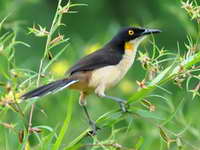Wrens are mainly small and inconspicuous, except for their loud and often complex songs. These birds have short wings and they cannot see at night. Several species often hold their tails upright and sleep on the ground. Wrens are insectivorous, eating insects and spiders but they will also eat fish, small rodents and lizards. The dominating colors of their plumage are drab, composed of gray, brown, black and white, and most species show some barring, especially to tail and/or wings. There is no sexual dimorphism in the plumage of wrens, and little difference between young birds and adults.
Wrens are principally a New World Family, distributed from Alaska and Canada to southern Argentina. A single species, the Winter Wren, is found not only in North America but also in Eastern Asia, Europe and marginally into North Africa. They species in a wide range of habitats, ranging from dry, sparsely wooded country to rainforest. The vast majority are found at low levels.
Genus Campylorhynchus
Wren,_Band-backed Campylorhynchus zonatus Found: Mexico, Central Amcerica, Columbia, Ecuador, Venezuela
The Band-backed Wren has Brown-gray crown; black nape; black-tawny-white barred rest of upperparts. Some subspecies have cinnamon or buff belly.
Similar to: Stripe-backed Wren. Band-backed Wren often has a rufous belly; Stripe-backed Wren has off-white belly. Ranges only overlay in small region of Columbia.
Image by: 1) Nick Athanas - Costa Rica 2) Dominic_Sherony - Costa Rica 3) Tim - Costa Rica 4) Jose AmorinSimilar to: Stripe-backed Wren. Band-backed Wren often has a rufous belly; Stripe-backed Wren has off-white belly. Ranges only overlay in small region of Columbia.


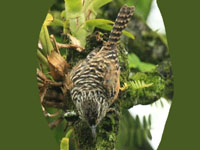

Wren,_Bicolored Campylorhynchus griseus Found: Colombia, Venezuela, Guyana, northern Brazil
The Bicolored Wren has brown upperparts; black cap, nape, eye-line; off-white underparts, supercilium.
Image by: 1) Tom Friedel (BirdPhotos.com) - Venezuela 2, 3) Barloventomagico - Venezuela 4) Nick Athanas - Columbia
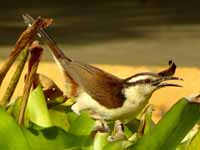


Wren,_Bouchard's Campylorhynchus jocosus Found: Mexico
The Bouchard's Wren has rufous upperparts with white spots; white underparts with dark spots; brown crown; white throat; black eye-line; whitish-and-black streaked nape; white supercilium; reddish eyes.
Image by: 1) Dominic Sherony 2) Jorge Montejo 3) Amy McAndrews 4) Nick Athanas - Mexico


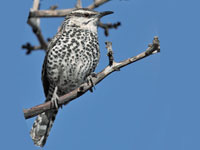
Wren,_Cactus Campylorhynchus brunneicapillus Found: arid regions - southwest United States, Mexico
The Cactus Wren has brown upperparts interspersed with white, white eye-stripe. It is the largest North American wren.
Image by: 1, 2) Dick Daniels - Arizona 3) Alan D. Wilson - Edinburg, Texas 4) Elaine R. Wilson - Borrego Springs, California 5, 6) Alan Vernon 7, 8)
New Jersy Birds - Arizona1) Juvenile



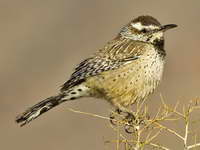

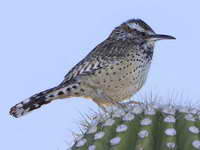


Wren,_Fasciated Campylorhynchus fasciatus Found: Ecuador, Peru
The Fasciated Wren has mainly gray upperparts with dark barring; whitish underparts with lighter barring.
Image by: 1) Francesco Veronesi - south Ecuador 2) Amy McAndrews - Peru 3) Nick Athanas - Ecuador


Wren,_Giant Campylorhynchus chiapensis Found: Mexico (Chiapas)
The Giant Wren has dark rufous mantle, wings; black crown, nape, eye-line; white supercilium, underparts.
Image by: 1) Nick Athanas 2) Amy McAndrews 3) Francesco Veronesi 4) Jerry Oldenettel



Wren,_Gray-barred Campylorhynchus megalopterus Found: Mexico
The Gray-barred Wren has black and white barred upperparts; grayish crown; pale eye-line; whitish underparts with brown spots; barred flanks.
Image by: 1) Ron_Knight Cornell_Univ's_Neotropical_Birds_Online - KirkH1

Wren,_Rufous-naped Campylorhynchus rufinucha Found: Mexico, Central America
The Rufous-naped Wren has cinnamon-brown upperparts streaked with black and white; rufous nape; black cap; white white supercilium; black eye-lne; black and grayish barred wings, tail; white underparts.;
Image by: 1) Joseph_Boone - Costa Rica 2) Cephas - Costa Rica 3) Nick Athanas - Costa Rica


Wren,_Spotted Campylorhynchus gularis Found: Mexico
The Spotted Wren has brown upperparts, barred tail; white supercilium; off-white underparts with spotted breast-band and flanks.
Image by: 1, 2, 3) Emily Hoyer
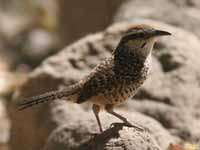

Wren,_Stripe-backed Campylorhynchus nuchalis Found: savannas of Columbia, Venezuela
Similar to: Band-backed Wren. Band-backed Wren often has a rufous belly; Stripe-backed Wren has off-white belly. Ranges only overlay in small region of Columbia.
Image by: 1) Fernando_Flores 2) Jerry Oldenettel - Venezuela 3) Cristóbal Alvarado Minic - Venezuela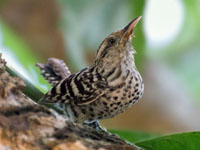


Wren,_Thrush-like Campylorhynchus turdinus Found: Brazil, Bolivia, Columbia, Ecuador, Paragua, Peru
The Thrush-like Wren has brown upperparts; dark barring on wings; off-white underparts can be plain or spotted.
Image by: 1) Carlos_Henrique 2) Hector_Bottai - Brazil 3, 4) Nick Athanas - Brazil, Ecuador 3) C. t. unicolor 4) C. t. hypostictus




Wren,_White-headed Campylorhynchus albobrunneus Found: Panama, Columbia, Venezuela
Brownish-black upperparts; white head, nape, underparts.
Image by: 1) Nick Athanas - Columbia 2) Tony_Castro - Panama

Wren,_Yucatan Campylorhynchus yucatanicus Found: northern Yucatán Peninsula of Mexico
The Yucatan Wren has brown upperparts streaked black and white; faint eye-line, malar stripe; whitish underparts with blackish spotting and barring.
Image by: 1) Amy_McAndrews 2) Luis Guillermo

Genus Cantorchilus
Wren,_Bay Cantorchilus nigricapillus Found: Columbia, Costa Rica, Ecuador, Nicaragua, Panama
The Bay Wren has rufous-brown upperparts; mainly black head with white ear coverts; white throat. Underparts vary geographicall.;
Image by: 1) Jerry Oldenettel -Costa Rica 2) Nick Athanas - Ecuador
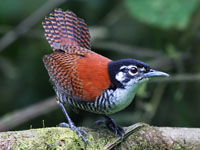
Wren,_Buff-breasted Cantorchilus leucotis Found: Panama, middle and northern South America
The Buff-breasted Wren has rufous-brown or grayish-brown (depending on location) upperparts, head; heavily barred wings, tail; buffy breast becoming more cinnamon on belly; gray-black upper mandible; lighter lower mandible.
Similar to: Fawn-breasted Wren. Ranges of Burr-breasted Wren and Fawn-breasted Wre nmainly do not overlap. Fawn-breasted is grayer above with more strongly streaked cheeks and a buffier throat; as compared to the race of Buff-breasted Wren that extends into southwestern Brazil.
Image by: 1) Hector Bottai - Brazil 2) JulaniPhotos 3) Clodomiro_EstevesSimilar to: Fawn-breasted Wren. Ranges of Burr-breasted Wren and Fawn-breasted Wre nmainly do not overlap. Fawn-breasted is grayer above with more strongly streaked cheeks and a buffier throat; as compared to the race of Buff-breasted Wren that extends into southwestern Brazil.



Wren,_Fawn-breasted Cantorchilus guarayanus Found: mainly Bolivia; also Brazil, Paraguay
The Fawn-breasted Wren has rufous upperparts; buffy underparts; black barred wings, tail; buffy-white throat, supercilium; brown and white streaked cheeks.
Similar to: Buff-breasted Wren. Ranges of Burr-breasted Wren and Fawn-breasted Wre nmainly do not overlap. Fawn-breasted is grayer above with more strongly streaked cheeks and a buffier throat; as compared to the race of Buff-breasted Wren that extends into southwestern Brazil.
Image by: 1) Claudio_Timm 2) Carlos_HenriqueSimilar to: Buff-breasted Wren. Ranges of Burr-breasted Wren and Fawn-breasted Wre nmainly do not overlap. Fawn-breasted is grayer above with more strongly streaked cheeks and a buffier throat; as compared to the race of Buff-breasted Wren that extends into southwestern Brazil.


Wren,_Gray Cantorchilus griseus Found: northwest Brazil
The Gray Wren has mainly gray plumage; long bill; short tail.
Image by: 1) Cornell_Univ's_Neotropical_Birds_Online - Fabio_Olmos
Wren,_Long-billed Cantorchilus longirostris Found: eastern Brazil
Similar to: Buff-breasted Wren. Little over lap of range of Buff-breasted Wren and Long-billed Wren. Long-billed Wren does have a longer bill.
Image by: 1) Eveha 2, 3) Nick Athanas - Brazil 4) Dario_Sanches

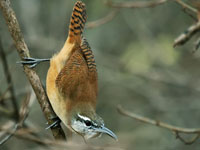

Wren,_Plain Cantorchilus modestus Found: Mexico, Central America
The Plain Wren has gray upperparts; white supercilium; pale underparts; cinnamon flanks.
Image by: 1) Don_Faulkner - Costa Rica 2) David Rodríguez Arias - Costa Rica 3) Cornell_Univ's_Neotropical_Birds_Online - Luke_Seitz


Wren,_Riverside Cantorchilus semibadius Found: mainly Costa Rica; also Panama
The Riverside Wren has chestnut upperparts; heavily barred rump, underparts, tail.
Image by: 1) David_Rodriguez_Arias 2, 3) Cornell_Univ's_Neotropical_Birds_Online - Larry_Servio


Wren_Stripe-breasted Cantorchilus thoracicus Found: Honduras, Nicaragua, Costa Rica, and Panama
The Stripe-breasted Wren has heavily black-and-white striped face, underparts.
Image by: 1) Francesco_Veronesi 2) Cornell_Univ's_Neotropical_Birds_Online - Jose_David_Siguenza_Leiva1) Adult and juvenile


Wren,_Stripe-throated Cantorchilus leucopogon Found: Columbia, Ecuador, Panama
The Stripe-throated Wren has tawny upperparts; dark streaked pale throat; barred wings.
Image by: 1, 2) Nick Athanas - Ecuador

Wren,_Superciliated Cantorchilus superciliaris Found: Ecuador, Peru
The Superciliated Wren has rufous upperparts; white suerpilium, throat, underparts; buffy flanks; dark eye-line.
Image by: 1) Nick Athanas - Peru 2) David_Cook - Peru

Genus Catherpes - 1 species
Wren, Canyon Catherpes mexicanus Found: dry, rocky environments - west United States, Mexico
The Canyon Wren has brown body, rufous tail, white throat, long thin bill. Usually found in arid rocky area.
Similar to: Rock Wren. Rock Wren has light gray stripe starting above the eye and proceeding towards back of head, Canyon wren does not have such a stripe.
Image by: 1) J N Stuart - New Mexico 2) Julio Mulero - California 3) Jerry Oldenettel - New Mexico 4) Jon David NelsonSimilar to: Rock Wren. Rock Wren has light gray stripe starting above the eye and proceeding towards back of head, Canyon wren does not have such a stripe.

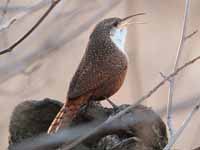
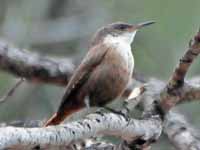

Genus Cinnycerthia
These species have reddish-brown plumage; dark bars on wings, tail; short bill.
Wren,_Fulvous Cinnycerthia fulva Found: Bolivia, southern Peru
The Fulvous Wren has mainly rufous plumage; pale supercilium; darkly barred wings, tail.
Image by: 1) Claudio_Timm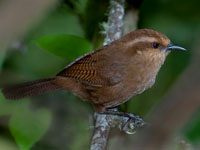
Wren,_Peruvian Cinnycerthia peruana Found: Peru
The Peruvian Wren has mainly rufous-brown plumage; back barring on wings, tail. Some adults have white on face.
Similar to: Sharpe's Wren. Peruvian Wren is paler than Sharpe's Wren. Sharpe's Wren is found north of Peruvian Wren.
Image by: 1, 2) Nick AthanasSimilar to: Sharpe's Wren. Peruvian Wren is paler than Sharpe's Wren. Sharpe's Wren is found north of Peruvian Wren.


Wren,_Rufous Cinnycerthia unirufa Found: Colombia, Ecuador, Peru, Venezuela
The Rufous Wren has mainly rufous plumage; faint black barring on wings, tail; blackish lores.
Image by: 1) Nick Athanas - Ecuador 
Wren,_Sharpe's Cinnycerthia olivascens Found: Columbian, Ecuador, northern Peru
Similar to: Peruvian Wren. Peruvian Wren is paler than Sharpe's Wren. Sharpe's Wren is found north of Peruvian Wren.
Image by: 1) José Loaiza 2) Nick Athanas - Ecuador

Genus Cistothorus
Wren,_Apolinar's Cistothorus apolinari Found: Andes of central Columbia
The Apolinar's Wren has light brown upperparts; white barring on wings, back, head; gray supercilium.
Image by: 1) Neil Orlando Diaz Martinez 2) Nick Athanas - Columbia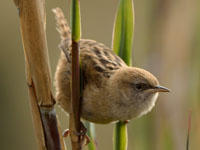

Wren,_Marsh Cistothorus palustris Found: Marshes in tall vegetation - North America
The Marsh Wren has brown upperparts with black and white stripes on part of back, light brown underparts, off white throat, dark brown cap, white supercilium.
Similar to: Sedge Wren. Marsh Wren has stripes in middle of back, Sedge Wren has faint stripes over entire back.
Image by: 1) Winnu - British Columbia 2) tgreyfox - Vancouver, Canada
3) Alan Wilson - California 4) juvethski - Vancouver 5) Steve Arena - MassachusettsSimilar to: Sedge Wren. Marsh Wren has stripes in middle of back, Sedge Wren has faint stripes over entire back.

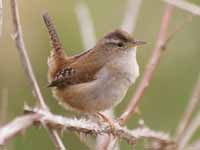



Wren,_Merida Cistothorus meridae Found: Andes of western Venezuela
The Merida Wren has brown plumage with complex dark brown and white barring; white supercilium.
Image by: 1) Cornell_Univ's_Neotropical_Birds_Online - Margareta_Wieser
Wren,_Sedge Cistothorus platensis Found: short grass and marshes - east North America, South America
The Sedge Wren has dark-brown streaked upperparts, light brown underparts, off white throat, dark brown cap, white supercilium.
Similar to: Marsh Wren. Marsh Wren has stripes in middle of back, Sedge Wren has faint stripes over entire back.
Image by: 1, 2, 3, 4) Nick Athanas - Ecuador, Brazil, Argentina, Falkand Islands 5) SolidElectronics - Ontario 6) Ken Schneider - IllinoisSimilar to: Marsh Wren. Marsh Wren has stripes in middle of back, Sedge Wren has faint stripes over entire back.
1) C. p. aequatorialis 2) C. p, polyglottus 3) C. p. tucumanus 4) C. p. falklandicus


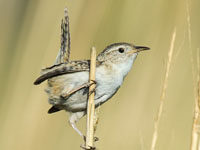



Genus Cyphorhinus
Wren,_Musician Cyphorhinus arada Found: Amazon rainforest of South America
The Musician Wren is known for its beautiful songs. It has various amounts of white of the head.
Image by: 1) Nick Athanas - Ecuador 2) Cornell_Univ's_Neotropical_Birds_Online - MARCELO_CAMACHO

Wren,_Song Cyphorhinus phaeocephalus Found: Honduras to Ecuador
The Song Wren has mainly brown plumage; chestnut throat; black barring on wings, tail; bare pale blue orbital patch,
Image by: 1, 2) Dave Curtis - Panama 3) Nick Athanas - Ecuador


Genus Ferminia - 1 species
Wren,_Zapata Ferminia cerverai Found: Zapata Swamp, Cuba
The Zapata Wren has brown upperparts with black barring; pale grayish underparts.
Image by: 1) Dominic_Sherony 2) Jerry_Oldenettel 3) Cornell_Univ's_Neotropical_Birds_Online - Wren,_Zapata


Genus Henicorhina
Wren,_Bar-winged_Wood- Henicorhina leucoptera Found: mainly Peru; also Ecuador
The Bar-winged Wood-Wren has rufous upperparts; two white bars on black wings; gray underparts with rufous flanks.
Image by: 1) Ana_Agreda 2) Cornell_Univ's_Neotropical_Birds_Online - Luke_Steitz

Wren,_Gray-breasted_Wood- Henicorhina leucophrys Found: Mexico to Bolivia
Similar to: Munchique Wood-Wren. The Munchique Wood-Wren has more barring on flanks than Gray-breated Wood-Wren.
Image by: 1) Nick Athanas - Columbia 2) Francesco_Veronesi

Wren,_Munchique_Wood-Henicorhina negreti Found: western Columbia
The Munchique Wood-Wren has rufous upperparts, flanks; brown head with white supercilium and black eye-line; gray underparts.
Similar to: Gray-breasted Wood-Wren. The Munchique Wood-Wren has more barring on flanks than Gray-breated Wood-Wren.
Image by: 1, 2) Brendan_RyanSimilar to: Gray-breasted Wood-Wren. The Munchique Wood-Wren has more barring on flanks than Gray-breated Wood-Wren.

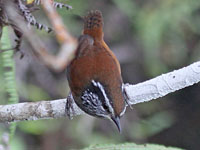
Wren,_White-breasted_Wood- Henicorhina leucosticta Found: southern Mexico to northern South America
The White-breasted Wood-Wren has warm brown upperparts; barred darker wings, tails; darker head with long white supercilium; mainly white underparts becoming buff towards vent.
Image by: 1) Alejandro_Tamayo 2) Andres_Cuervo 3) Nick Athanas - Costa Rica1) Juvenile


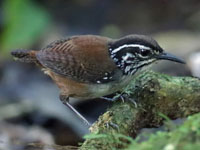
Genus Hylorchilus
Wren,_Nava's Hylorchilus navai Found: southern Mexico
The Nava's Wren has mainly brown plumage; pale throat, upper-breast.
Similar to: Sumichrast's Wren. The Nava's Wren has faint streaking on the underparts; Sumichrast's has no streaking on the underparts.
Image by: 1) Francesco_Veronesi 2) Nick_AthanasSimilar to: Sumichrast's Wren. The Nava's Wren has faint streaking on the underparts; Sumichrast's has no streaking on the underparts.


Wren,_Sumichrast's Hylorchilus sumichrasti Found: southern Mexico
Similar to: Nava's Wren. The Nava's Wren has faint streaking on the underparts; Sumichrast's has no streaking on the underparts.
Image by: 1) Cornell_Univ's_Neotropical_Birds_Online - A_Horden 2) Chivirin 3) Jerry_Oldenettel
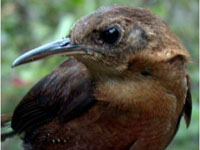
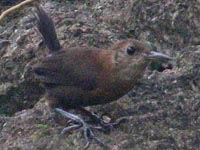
Genus Microcerculus
Wren,_Flutist Microcerculus ustulatus Found: Brazil, Guyana, Venezuela
The Flutist Wren has dark brown upperparts; rufous underparts; short tail.
Image by: 1, 2) David_Ascanio Cornell_Univ's_Neotropical_Birds_Online - Anselmo_d'Affonseca, David_Ascanio

Wren,_Nightingale Microcerculus philomela Found: Belize, Costa Rica, Guatemala, Honduras, Mexico, Nicaragua
The Nightingale Wren has dark brown upperparts; pale gray throat, breast; black tipped feathers give scalloped look.
Image by: 1, 2) David Rodríguez Arias

Wren,_Scaly-breasted also Southern Nigthingale-Wren Microcerculus marginatus Found: Costa Rica, Panama, South America
The Scaly-breasted Wren has dull brown upperparts. flanks. Underparts white or white with brown scaling. The Scaly-breasted Wren used to be consider conspecific with the Nightingale Wren.
Image by: 1) Andres_Cuervo 2, 3, 4) Nick Athanas - Ecuador, Panama, Columbia 2) M. m. taeniatus 3) M. m. luscinia 4) M. m. occidentalis




Wren,_Wing-banded Microcerculus bambla Found: Brazil, Ecuador, French Guiana, Guyana, Peru, Suriname, Venezuela
The Wing-banded Wren has dark brown upperparts; darker wings with bold white bar; gray underparts.
Image by: 1) Nick Athanas 2) Cornell_Univ's_Neotropical_Birds_Online - Silvia_Faustino_Linhares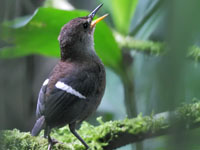

Genus Odontorchilus
These small grey wrens are relatively long-tailed (giving them a superficially gnatcatcher-like appearance), and, uniquely in the family, they live in the canopy and subcanopy of humid forest.
Wren,_Gray-mantled Odontorchilus branickii Found: Andes from southern Columbia to northern Bolivia
The Gray-mantled Wren has gray upperparts; dull brown crown; gray tail with black bars; white underparts.
Similar to: Tooth-billed Wren. The Gray-mantled Wren has white underparts. Tooth-billed Wren has pale buff underparts. Ranges do not overlap.
Image by: 1) Joseph_Smit 2) ProAves Colombia - EcuadorSimilar to: Tooth-billed Wren. The Gray-mantled Wren has white underparts. Tooth-billed Wren has pale buff underparts. Ranges do not overlap.
1) Cornell_Univ's_Neotropical_Birds_Online - Glenn_Bartley, Joel_Rosenthal


Wren,_Tooth-billed Catherpes mexicanus Found: mainly Brazil; also bordering Bolivia
The Tooth-billed Wren has dull gray upperparts; pale buff underparts. The "tooth" on the bill for which this bird is named is only a small notch, and is not apparent in the field.
Similar to: Gray-mantled Wren. The Gray-mantled Wren has white underparts. Tooth-billed Wren has pale buff underparts. Ranges do not overlap.
Image by: 1) Nick Athanas - Brazil 2) Jorge_Montejo - BrazilSimilar to: Gray-mantled Wren. The Gray-mantled Wren has white underparts. Tooth-billed Wren has pale buff underparts. Ranges do not overlap.


Genus Pheugopedius
Wren,_Black-bellied Pheugopedius fasciatoventris Found: Costa Rica, Panama, Columbia
The Black-bellied Wren has chestnut upperparts; white supercilium; black eye-line; white throat, upper-breast; black breast-band; black and white barred belly.
Image by: 1, 2) Cornell_Univ's_Neotropical_Birds_Online - Jorge_Gabriel_Campos, Gualberto_Becerra

Wren,_Black-throated Pheugopedius atrogularis Found:Costa Rica, Nicaragua, Panama
The Black-throated Wren has reddish-brown upperparts; black face, throat, breast; thin white supercilium.
Image by: 1) Cornell_Univ's_Neotropical_Birds_Online - David_Seible
Wren,_Coraya Pheugopedius coraya Found: northern South America
The Coraya Wren has rufous upperparts; whitish underparts; gray breast sides; buffy flanks; dark and pale brown barred tail; dark cap; black face with thin white lateral stripes.
Image by: 1) Philip_Stouffer - Brazil1) Cornell_Univ's_Neotropical_Birds_Online - Kester_Clarke

Wren,_Happy Pheugopedius felix Found: Mexico
The Happy Wren has brown upperparts, crown; black and white striped face; white throat; buff underparts.
Similar to: Inca Wren. Range of Happy Wren and Inca Wren do not overlap.
Image by: 1) Francesco_VeronesiSimilar to: Inca Wren. Range of Happy Wren and Inca Wren do not overlap.

Wren,_Inca Pheugopedius eisenmanni Found: Peru
Similar to: Happy Wren. Range of Happy Wren and Inca Wren do not overlap.
Image by: 1) Nick Athanas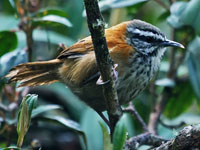
Wren,_Moustached Pheugopedius genibarbis Found: Bolivia, Brazil, Peru
The Moustached Wren has rufous back, wings; gray head with black and white facial stripes; black barred tail.
Similar to: Whiskered Wren. Ranges of Moustached Wren and Whiskered Wren do not overlap.
Image by: 1) Nick Athanas - Brazil 2) Francesco_Veronesi - BrazilSimilar to: Whiskered Wren. Ranges of Moustached Wren and Whiskered Wren do not overlap.


Wren,_Plain-tailed Pheugopedius euophrys Found: southern Columbia, Ecuador, northern Peru
The Plain-tailed Wren has olive-rufous upperparts; rufous wings; buffy-gray underparts; gray, black, and white striped head; unbarred tail.
Image by: 1) Nick Athanas 2) Browerk - Ecuador

Wren,_Rufous-breasted Pheugopedius rutilus Found: Costa, Rica, Columbia, Venezuela, Tobago.
The Rufous-breasted Wren has gray-brown upperparts; black bars on tail; black and white speckled face, throat; rufous breast; brownish-white belly; brown flanks.
Image by: 1) Francesco_Veronesi - Panama 2) Nick Athanas - Panama

Wren,_Sooty-headed Pheugopedius spadix Found: mainly Columbia; also Panama
The Sooty-headed Wren has rufous upperparts; blackish head with some white; chestnut breast, flanks; black bars on tail.
Image by:
Wren,_Speckled-breasted Pheugopedius sclateri Found: mainly Ecuador; also Colubia, Peru
The Speckled-breasted Wren has dull rufous-brown upperparts; mottled black-and-white face, breast, upper flanks; white belly.
Image by: 1, 2) Nick Athanas - Ecuador1) P. s, sclateri 2) P. s. paucimaculatus


Wren,_Spot-breasted Pheugopedius maculipectus Found: Mexico, Central America
The Spot-breasted Wren has tawny-brown upperparts; whitish face with black stripes; black eye-line; whitish underparts with black spots; brown tail with black bars.
Image by: 1) Carol_Foil - Belize 2) Francesco_Veronesi - Mexico

Wren,_Whiskered Pheugopedius mystacalis Found: Colombia, Ecuador, Venezuela
The Whiskered Wren has rufous back, wings; gray head with black and white facial stripes; black barred tail.
Similar to: Moustached Wren. Ranges of Moustached Wren and Whiskered Wren do not overlap.
Image by: Similar to: Moustached Wren. Ranges of Moustached Wren and Whiskered Wren do not overlap.
Genus Salpinctes - 1 species
Wren, Rock Salpinctes obsoletus Found: west North America, Central America
The Rock Wren has gray-brown upperparts with small black and white spots, pale gray underparts with light brown rump, light gray supercilium. They breed in dry rocky areas.
Similar to: Canyon Wren. Rock Wren has light gray stripe starting above the eye and proceeding towards back of head, Canyon wren does not have such a stripe.
Image by: 1) Jeff Whitlock - Texas 2) Marcel Holyoak - California 3) Alan D. Wilson - New Mexico 4) Linda Tanner Similar to: Canyon Wren. Rock Wren has light gray stripe starting above the eye and proceeding towards back of head, Canyon wren does not have such a stripe.




Genus Thryomanes - 1 species
Wren,_Berwick's Thryomanes bewickii Found: North America
The Berwick's Wren has gray-brown upperparts, white underparts, barring on flanks usually visible, white supercilium, white throat,
Similar to: Carolina Wren. Berwick's Wren is smaller but with a longer tail, grayer-brown above and whiter below than Carolina Wren.
Image by: 1) Charlie Westerinen - Nevada 2) Becky_Matsubara 3) Minette Layne - Washington 4) Ingrid Taylor - Oregon Similar to: Carolina Wren. Berwick's Wren is smaller but with a longer tail, grayer-brown above and whiter below than Carolina Wren.


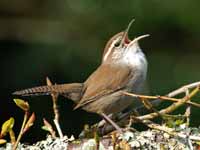

Genus Thryophilus
Most species are rufous or brown, and have black and white streaks on the side of the face.
Wren,_Antioquia Thryophilus sernai Found: Columbia
Image by: 1) Cornell_Univ's_Neotropical_Birds_Online - Carlos_Esteban_Lara

Wren,_Banded Thryophilus pleurostictus Found: Mexico, Central America
The Banded Wren has chestnut brown upperparts; bold white supercilium; dark eye-line; black streaking on face; white underparts wit black barring on flanks.
Image by: 1) Jerry_Oldenettel - Mexico 2) Nick Athanas - Mexico

Wren,_Niceforo's Thryophilus nicefori Found: Columbia
The Niceforo's Wren has rufous-brown upperparts; olive-brown crown; white supercilium;
Image by: 1) Cornell_Univ's_Neotropical_Birds_Online - Chris_Bell
Wren,_Rufous-and-white Thryophilus rufalbus Found: Mexico, Central America, Columbia, Venezuela
The Rufous-and-white Wren has chestnut-brown upperparts; white supercilium; brown eye-line; white underparts with black barring on lower belly; brown flanks.
Image by: 1) Andres_Cuervo 2) Aaron_Maizlish - Panama 3) _Cornell_Univ's_Neotropical_Birds_Online - Rual_Vega 
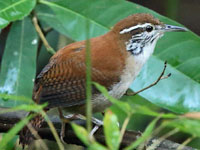

Wren,_Sinaloa Thryophilus sinaloa Found: Mexico
The Sinoloa Wren has plain brown upperparts; white supercilium; white throat, center of breast becoming grayish cinnamon on the flanks.
Image by: 1) Seabamirum 2) Nigel_Voaden Cornell_Univ's_Neotropical_Birds_Online - Nigel_Voaden, Glen_Tepke


Genus Thryothorus - 1 species
Wren,_Carolina Thryothorus ludovicianus Found: North America (eastern)
The Carolina Wren has rufous upperparts, orange buff underparts, barring on flanks usually visible, white supercilium, white throat and cheeks,
Similar to: Berwick's Wren. Berwick's Wren is smaller but with a longer tail, grayer-brown above and whiter below than Carolina Wren.
Image by: 1) Don Poncamo - Texas 2, 4, 5, 6, 7) Dick Daniels - Carolinas 3) New Jersy Birds 8) Amy McAndrews - MexicoSimilar to: Berwick's Wren. Berwick's Wren is smaller but with a longer tail, grayer-brown above and whiter below than Carolina Wren.





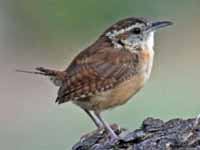


Genus Thryorchilus-1 species
Wren,_Timberline Thryorchilus browni Found: Costa Rica, Panama
The Timberline Wren has brown upperparts; wide white supercilium; white partial eye-ring; wide brown line to rear of eye; white below; pale underparts with brown flanks. Generally found at elevations above Ochraceous Wren.
Image by: 1) Nick Athanas - Costa Rica 2) Michael_Woodruff - Costa Rica 3) Pable Siles.
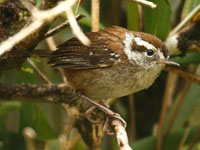

Genus Troglodytes
Wren,_Clarion Troglodytes tanneri Found: Clarión Island off western Mexico
The Clarion Wren has gray-brown upperparts; whitish supercilium, eye-ring; pale buff underparts.
Image by: 1) Cornell_Univ's_Neotropical_Birds_Online - Amy_McAndrews
Wren,_Cobb's Troglodytes cobbi Found: Flakland Islands
The Cobb's Wren has brown plumage; lighter underparts; some barring on upperparts.
Image by: 1) GeForce3 2, 3) Nick Athanas


Wren,_Eurasian Troglodytes troglodytes Found: Europe, Asia
The Eurasian Wren has rufous upperparts with faint white barring, light brownish-gray underparts, short tail perhaps a supercilium depending on the subspecies. It likes to hang out in cavities,
Related to: Winter Wren. Winter Wren and Eurasian Wren were once considered one species. The Eurasian Wren is the only member of the wren family Troglodytidae in Europe, Asia
Image by: 1) Robert Lorch 2) Jan_Svetlik 3) Agustin_Povedano 4) Koshy_Koshy - India Related to: Winter Wren. Winter Wren and Eurasian Wren were once considered one species. The Eurasian Wren is the only member of the wren family Troglodytidae in Europe, Asia




Wren,_House Troglodytes aedon Found: The Americas
The House Wren has brown upperparts; faint eye-ring; barring to the wings, tail, and flanks; long thin bill; black upper mandible, lighter lower mandible. Depending on the subspecies it has light brown, gray, or white underparts; pink or gray legs. Tail is often held cocked.
Image by: 1) Calibas - Colorado 2) New
Jersy Birds - New Jersey 3) Per Verdonk - Michigan 4) S. King - New Mexico 5) Ted Llovet - California 6) Ken Schneider - Illinois 7) Dick Daniels - Peru 8) Dick - near Penonome, Panama





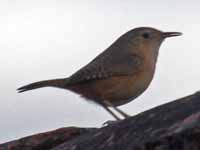

Southern House Wren Troglodytes aedon musculus Found: South America
Image by: 1, 2, 3, 4) Dario Sanches - Brazil
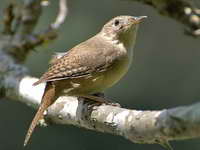


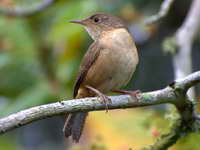
Wren,_Mountain Troglodytes solstitialis Found: the Andes from Venezuela to Argentina
The Mountain Wren has mainly brown upperparts paler underparts;; barred wings and tail; pale supercilium;
Image by: 1) Francesco_Veronesi - Ecuador 2, 3) Nick Athanas - Ecuador, Argentina2) T. s. solstitialis 3) T. s, auricularis



Wren,_Ochraceous Troglodytes ochraceus Found: Costa Rica, Panama
The Ochraceous Wren has pale brown upperparts; buff underparts becoming whitish on belly; rich ochre sides of head; pale arc rear of eye.. Generally found at elevations below Timberline Wren.
Image by: 1) Nick Athanas - Costa Rica 2) Cornell_Univ's_Neotropical_Birds_Online - Jorge_Eduardo in Costa Rica

Wren,_Pacific Troglodytes pacificus Found: west North America
The Pacific Wren has rufous plumage barred with darker brown, light supercilium. It has a chubby appearance.
Similar to: Winter Wren. Winter Wren and Pacific Wren were once considered one species. Their ranges usually do not overlap.
Image by: 1) Julio Mulero - California 2) Brian & Jessi - Washington 3) Jacob_McGinnisSimilar to: Winter Wren. Winter Wren and Pacific Wren were once considered one species. Their ranges usually do not overlap.



Wren,_Rufous-browed Troglodytes rufociliatus Found: El Salvador, Guatemala, Honduras, Mexico, and Nicaragua
The Rufous-browed Wren has rufous supercilium; barred flanks.
Image by: 1) Alan_Harper - Honduras 2) Dominic Sherony

Wren,_Santa_Marta Troglodytes monticola Found: Santa Marta mountains of northern Columbia
The Santa Marta Wren has brown upperparts; buffy supercilium; fine black barring on wings, tail, flanks, undertail.
Image by: 1, 2) Cornell_Univ's_Neotropical_Birds_Online - Alonso Quevedo_Gil

Wren,_Socorro Troglodytes sissonii Found: Socorro Island of Mexico
The Socorro Wren has brown upperparts; pale buff eye-ring; buff supercilium; dark bars on wings, tail; whitish throat, underparts. It is only species of wren on Socorro Island.
Image by: 1) Cornell_Univ's_Neotropical_Birds_Online - Amy_McAndrews
Wren,_Tepui Troglodytes rufulus Found: southeast Venezuela and adjacent Brazil, Guyana
The Tepui Wren has brown upperparts; paler underparts; black barring on wings, tail; buffy supercilium. The tepuis are the massive table-top mountains that are isolated in northern South America away from the Andes.
Image by: 1) Cornell_Univ's_Neotropical_Birds_Online - Jose_Almir_Jacomelli
Wren,_Winter Troglodytes hiemalis Found: east North America
The Pacific Wren has brown upperparts, gray-brown underparts with some barring, light supercilium. It has a chubby appearance.
Similar to: Eurasian Wren. Winter Wren and Eurasian Wren were once considered one species. The Eurasian Wren is the only member of the wren family Troglodytidae in Europe, Asia
Similar to: Pacific Wren. Winter Wren and Pacific Wren were once considered one species. Their ranges usually do not overlap.
Image by: 1, 2) Kelly Azar - Pennsylvania 3) Ed Gaillard - New YorkSimilar to: Eurasian Wren. Winter Wren and Eurasian Wren were once considered one species. The Eurasian Wren is the only member of the wren family Troglodytidae in Europe, Asia
Similar to: Pacific Wren. Winter Wren and Pacific Wren were once considered one species. Their ranges usually do not overlap.
3) after a bath



Genus Uropsila - 1 species
Wren,_White-bellied Uropsila leucogastra Found: Mexico, Belize, Guatemala, Honduras
The White-bellied Wren has brown upperparts; pale supercilium, underparts.
Image by: 1) Cornell_Univ's_Neotropical_Birds_Online - Romel_Romero 2) Nick Athanas - Mexico

There is disagreement over where to place the Donacobius. Some have suggested that they are relsted to wrens.
Genus Donacobius - 1 species
Donacobius,_Black-capped Donacobius atricapilla Found: Central and South America
Image by: 1) Claudio Timm - the Amazon, Brazil 2) Dario Sanches 3) Carlos_Henrique 4) Cristiano Crolle - Argentina 5) Nick Athanas - Brazil
